warning JEEP CHEROKEE 2020 Owner handbook (in English)
[x] Cancel search | Manufacturer: JEEP, Model Year: 2020, Model line: CHEROKEE, Model: JEEP CHEROKEE 2020Pages: 332, PDF Size: 8.87 MB
Page 54 of 332
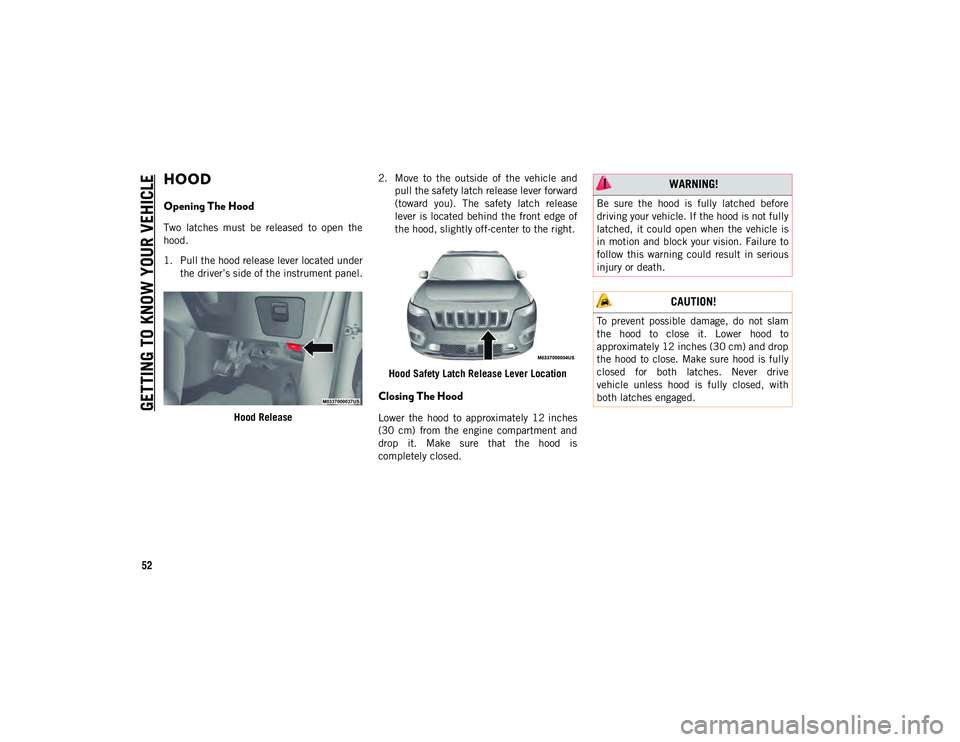
GETTING TO KNOW YOUR VEHICLE
52
HOOD
Opening The Hood
Two latches must be released to open the
hood.
1. Pull the hood release lever located underthe driver’s side of the instrument panel.
Hood Release 2. Move to the outside of the vehicle and
pull the safety latch release lever forward
(toward you). The safety latch release
lever is located behind the front edge of
the hood, slightly off-center to the right.
Hood Safety Latch Release Lever Location
Closing The Hood
Lower the hood to approximately 12 inches
(30 cm) from the engine compartment and
drop it. Make sure that the hood is
completely closed.
WARNING!
Be sure the hood is fully latched before
driving your vehicle. If the hood is not fully
latched, it could open when the vehicle is
in motion and block your vision. Failure to
follow this warning could result in serious
injury or death.
CAUTION!
To prevent possible damage, do not slam
the hood to close it. Lower hood to
approximately 12 inches (30 cm) and drop
the hood to close. Make sure hood is fully
closed for both latches. Never drive
vehicle unless hood is fully closed, with
both latches engaged.
2020_JEEP_CHEROKEE_UG_RHD_UK.book Page 52
Page 55 of 332
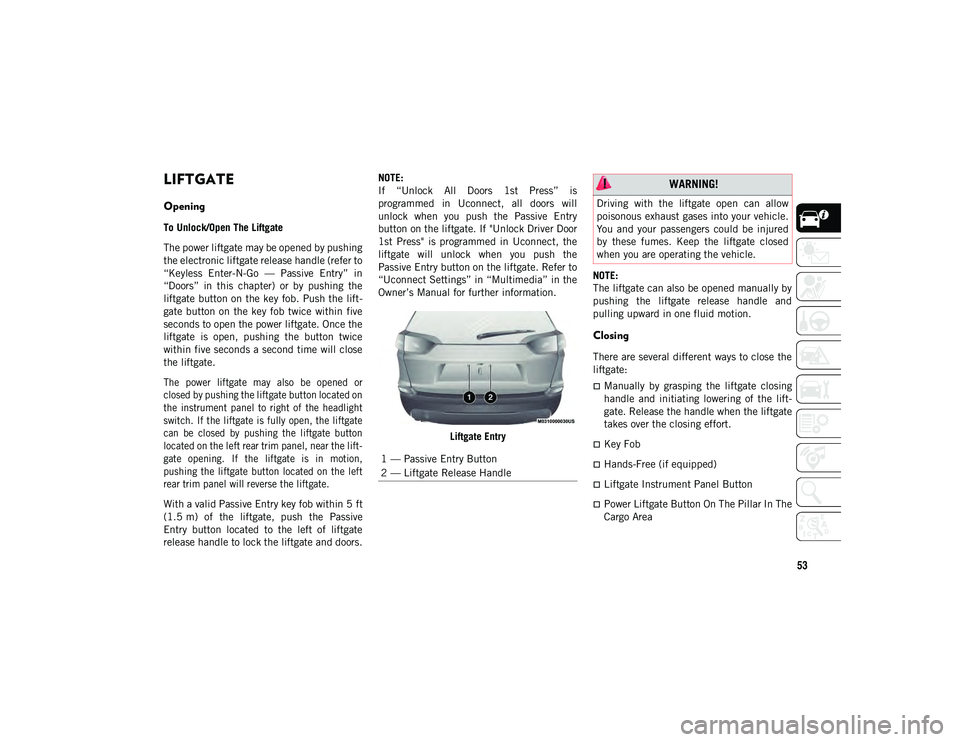
53
LIFTGATE
Opening
To Unlock/Open The Liftgate
The power liftgate may be opened by pushing
the electronic liftgate release handle (refer to
“Keyless Enter-N-Go — Passive Entry” in
“Doors” in this chapter) or by pushing the
liftgate button on the key fob. Push the lift-
gate button on the key fob twice within five
seconds to open the power liftgate. Once the
liftgate is open, pushing the button twice
within five seconds a second time will close
the liftgate.
The power liftgate may also be opened or
closed by pushing the liftgate button located on
the instrument panel to right of the headlight
switch. If the liftgate is fully open, the liftgate
can be closed by pushing the liftgate button
located on the left rear trim panel, near the lift -
gate opening. If the liftgate is in motion,
pushing the liftgate button located on the left
rear trim panel will reverse the liftgate.
With a valid Passive Entry key fob within 5 ft
(1.5 m) of the liftgate, push the Passive
Entry button located to the left of liftgate
release handle to lock the liftgate and doors. NOTE:
If “Unlock All Doors 1st Press” is
programmed in Uconnect, all doors will
unlock when you push the Passive Entry
button on the liftgate. If "Unlock Driver Door
1st Press" is programmed in Uconnect, the
liftgate will unlock when you push the
Passive Entry button on the liftgate. Refer to
“Uconnect Settings” in “Multimedia” in the
Owner’s Manual for further information.
Liftgate Entry NOTE:
The liftgate can also be opened manually by
pushing the liftgate release handle and
pulling upward in one fluid motion.
Closing
There are several different ways to close the
liftgate:
Manually by grasping the liftgate closing
handle and initiating lowering of the lift
-
gate. Release the handle when the liftgate
takes over the closing effort.
Key Fob
Hands-Free (if equipped)
Liftgate Instrument Panel Button
Power Liftgate Button On The Pillar In The
Cargo Area
1 — Passive Entry Button
2 — Liftgate Release Handle
WARNING!
Driving with the liftgate open can allow
poisonous exhaust gases into your vehicle.
You and your passengers could be injured
by these fumes. Keep the liftgate closed
when you are operating the vehicle.
2020_JEEP_CHEROKEE_UG_RHD_UK.book Page 53
Page 57 of 332
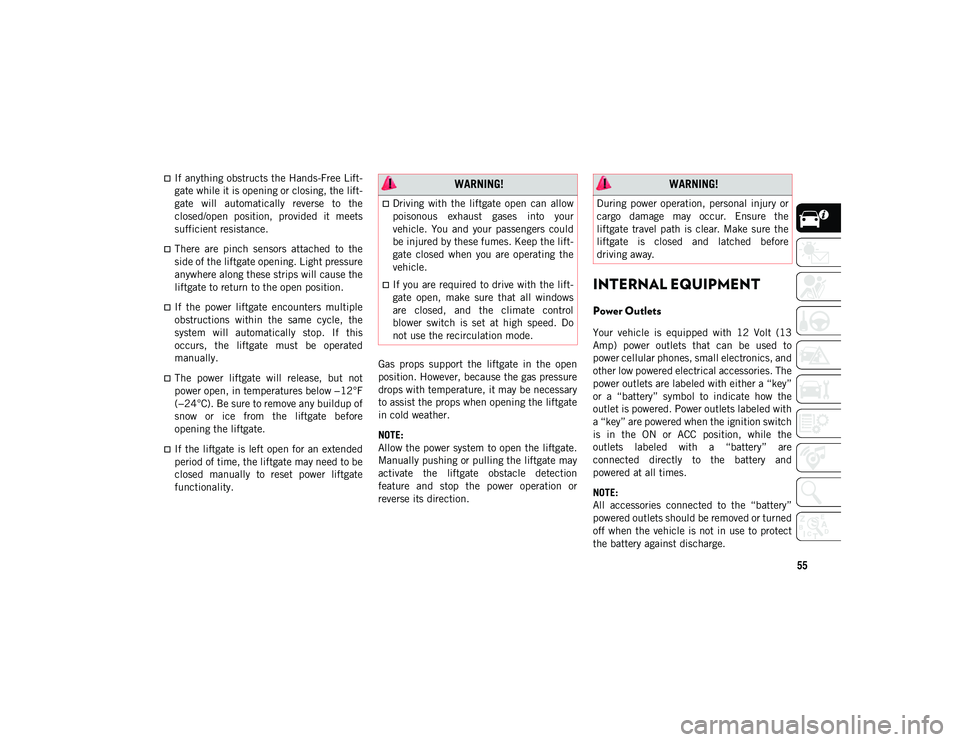
55
If anything obstructs the Hands-Free Lift-
gate while it is opening or closing, the lift -
gate will automatically reverse to the
closed/open position, provided it meets
sufficient resistance.
There are pinch sensors attached to the
side of the liftgate opening. Light pressure
anywhere along these strips will cause the
liftgate to return to the open position.
If the power liftgate encounters multiple
obstructions within the same cycle, the
system will automatically stop. If this
occurs, the liftgate must be operated
manually.
The power liftgate will release, but not
power open, in temperatures below −12°F
(−24°C). Be sure to remove any buildup of
snow or ice from the liftgate before
opening the liftgate.
If the liftgate is left open for an extended
period of time, the liftgate may need to be
closed manually to reset power liftgate
functionality. Gas props support the liftgate in the open
position. However, because the gas pressure
drops with temperature, it may be necessary
to assist the props when opening the liftgate
in cold weather.
NOTE:
Allow the power system to open the liftgate.
Manually pushing or pulling the liftgate may
activate the liftgate obstacle detection
feature and stop the power operation or
reverse its direction.
INTERNAL EQUIPMENT
Power Outlets
Your vehicle is equipped with 12 Volt (13
Amp) power outlets that can be used to
power cellular phones, small electronics, and
other low powered electrical accessories. The
power outlets are labeled with either a “key”
or a “battery” symbol to indicate how the
outlet is powered. Power outlets labeled with
a “key” are powered when the ignition switch
is in the ON or ACC position, while the
outlets labeled with a “battery” are
connected directly to the battery and
powered at all times.
NOTE:
All accessories connected to the “battery”
powered outlets should be removed or turned
off when the vehicle is not in use to protect
the battery against discharge.
WARNING!
Driving with the liftgate open can allow
poisonous exhaust gases into your
vehicle. You and your passengers could
be injured by these fumes. Keep the lift
-
gate closed when you are operating the
vehicle.
If you are required to drive with the lift -
gate open, make sure that all windows
are closed, and the climate control
blower switch is set at high speed. Do
not use the recirculation mode.
WARNING!
During power operation, personal injury or
cargo damage may occur. Ensure the
liftgate travel path is clear. Make sure the
liftgate is closed and latched before
driving away.
2020_JEEP_CHEROKEE_UG_RHD_UK.book Page 55
Page 58 of 332
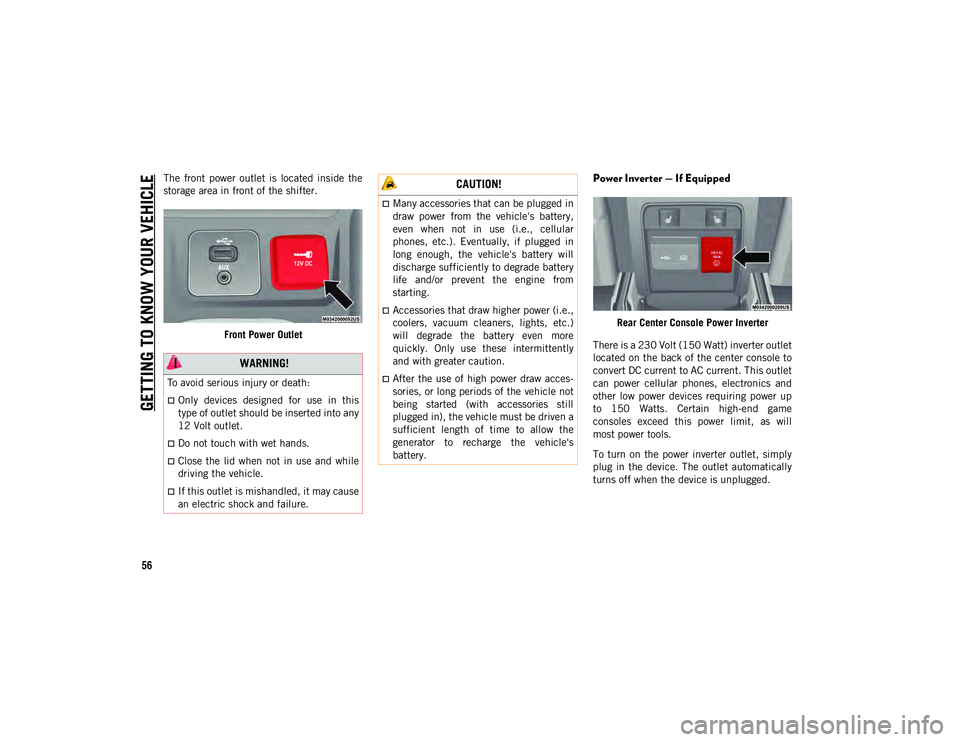
GETTING TO KNOW YOUR VEHICLE
56
The front power outlet is located inside the
storage area in front of the shifter.Front Power OutletPower Inverter — If Equipped
Rear Center Console Power Inverter
There is a 230 Volt (150 Watt) inverter outlet
located on the back of the center console to
convert DC current to AC current. This outlet
can power cellular phones, electronics and
other low power devices requiring power up
to 150 Watts. Certain high-end game
consoles exceed this power limit, as will
most power tools.
To turn on the power inverter outlet, simply
plug in the device. The outlet automatically
turns off when the device is unplugged.
WARNING!
To avoid serious injury or death:
Only devices designed for use in this
type of outlet should be inserted into any
12 Volt outlet.
Do not touch with wet hands.
Close the lid when not in use and while
driving the vehicle.
If this outlet is mishandled, it may cause
an electric shock and failure.
CAUTION!
Many accessories that can be plugged in
draw power from the vehicle's battery,
even when not in use (i.e., cellular
phones, etc.). Eventually, if plugged in
long enough, the vehicle's battery will
discharge sufficiently to degrade battery
life and/or prevent the engine from
starting.
Accessories that draw higher power (i.e.,
coolers, vacuum cleaners, lights, etc.)
will degrade the battery even more
quickly. Only use these intermittently
and with greater caution.
After the use of high power draw acces-
sories, or long periods of the vehicle not
being started (with accessories still
plugged in), the vehicle must be driven a
sufficient length of time to allow the
generator to recharge the vehicle's
battery.
2020_JEEP_CHEROKEE_UG_RHD_UK.book Page 56
Page 59 of 332
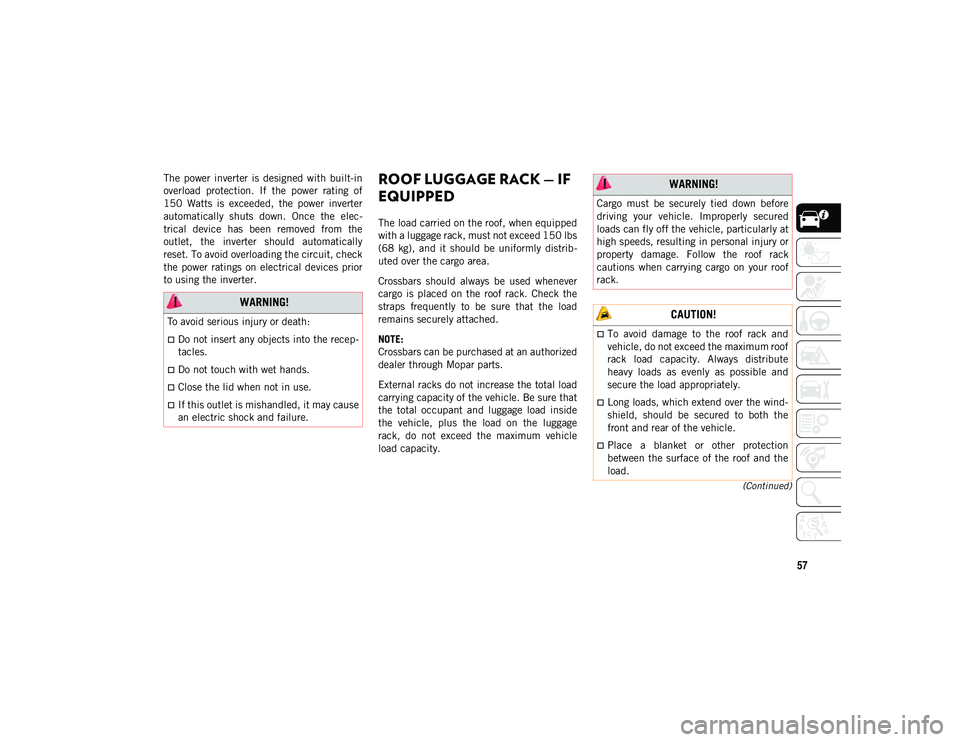
57
(Continued)
The power inverter is designed with built-in
overload protection. If the power rating of
150 Watts is exceeded, the power inverter
automatically shuts down. Once the elec-
trical device has been removed from the
outlet, the inverter should automatically
reset. To avoid overloading the circuit, check
the power ratings on electrical devices prior
to using the inverter.ROOF LUGGAGE RACK — IF
EQUIPPED
The load carried on the roof, when equipped
with a luggage rack, must not exceed 150 lbs
(68 kg), and it should be uniformly distrib -
uted over the cargo area.
Crossbars should always be used whenever
cargo is placed on the roof rack. Check the
straps frequently to be sure that the load
remains securely attached.
NOTE:
Crossbars can be purchased at an authorized
dealer through Mopar parts.
External racks do not increase the total load
carrying capacity of the vehicle. Be sure that
the total occupant and luggage load inside
the vehicle, plus the load on the luggage
rack, do not exceed the maximum vehicle
load capacity.
WARNING!
To avoid serious injury or death:
Do not insert any objects into the recep -
tacles.
Do not touch with wet hands.
Close the lid when not in use.
If this outlet is mishandled, it may cause
an electric shock and failure.
WARNING!
Cargo must be securely tied down before
driving your vehicle. Improperly secured
loads can fly off the vehicle, particularly at
high speeds, resulting in personal injury or
property damage. Follow the roof rack
cautions when carrying cargo on your roof
rack.
CAUTION!
To avoid damage to the roof rack and
vehicle, do not exceed the maximum roof
rack load capacity. Always distribute
heavy loads as evenly as possible and
secure the load appropriately.
Long loads, which extend over the wind -
shield, should be secured to both the
front and rear of the vehicle.
Place a blanket or other protection
between the surface of the roof and the
load.
2020_JEEP_CHEROKEE_UG_RHD_UK.book Page 57
Page 60 of 332
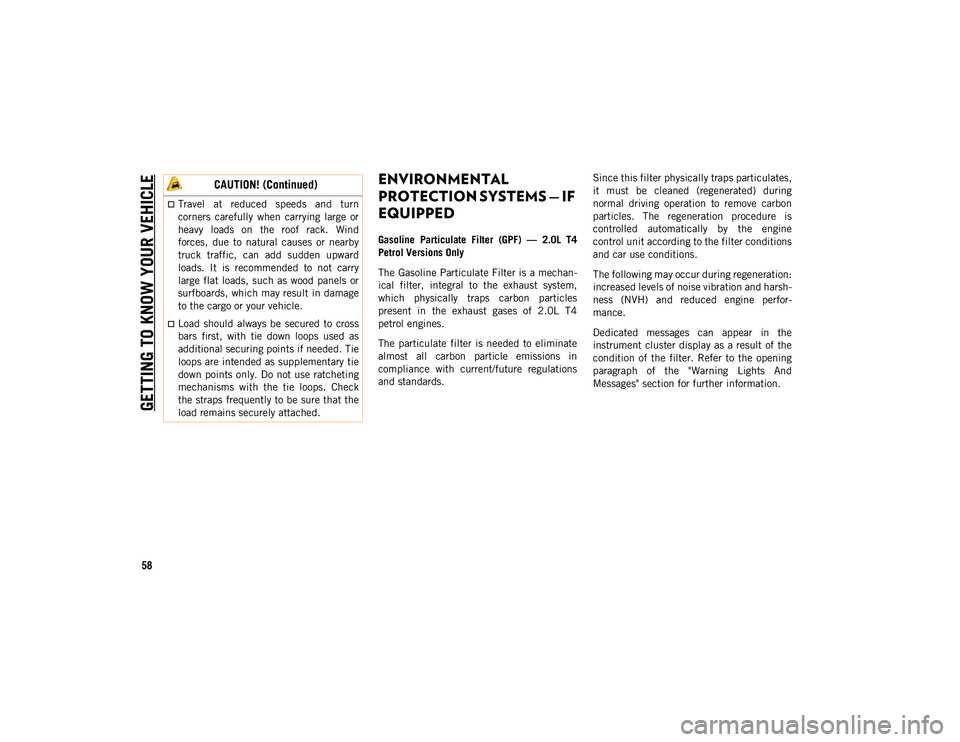
GETTING TO KNOW YOUR VEHICLE
58
ENVIRONMENTAL
PROTECTION SYSTEMS — IF
EQUIPPED
Gasoline Particulate Filter (GPF) — 2.0L T4
Petrol Versions Only
The Gasoline Particulate Filter is a mechan-
ical filter, integral to the exhaust system,
which physically traps carbon particles
present in the exhaust gases of 2.0L T4
petrol engines.
The particulate filter is needed to eliminate
almost all carbon particle emissions in
compliance with current/future regulations
and standards. Since this filter physically traps particulates,
it must be cleaned (regenerated) during
normal driving operation to remove carbon
particles. The regeneration procedure is
controlled automatically by the engine
control unit according to the filter conditions
and car use conditions.
The following may occur during regeneration:
increased levels of noise vibration and harsh
-
ness (NVH) and reduced engine perfor -
mance.
Dedicated messages can appear in the
instrument cluster display as a result of the
condition of the filter. Refer to the opening
paragraph of the "Warning Lights And
Messages" section for further information.
Travel at reduced speeds and turn
corners carefully when carrying large or
heavy loads on the roof rack. Wind
forces, due to natural causes or nearby
truck traffic, can add sudden upward
loads. It is recommended to not carry
large flat loads, such as wood panels or
surfboards, which may result in damage
to the cargo or your vehicle.
Load should always be secured to cross
bars first, with tie down loops used as
additional securing points if needed. Tie
loops are intended as supplementary tie
down points only. Do not use ratcheting
mechanisms with the tie loops. Check
the straps frequently to be sure that the
load remains securely attached.
CAUTION! (Continued)
2020_JEEP_CHEROKEE_UG_RHD_UK.book Page 58
Page 61 of 332
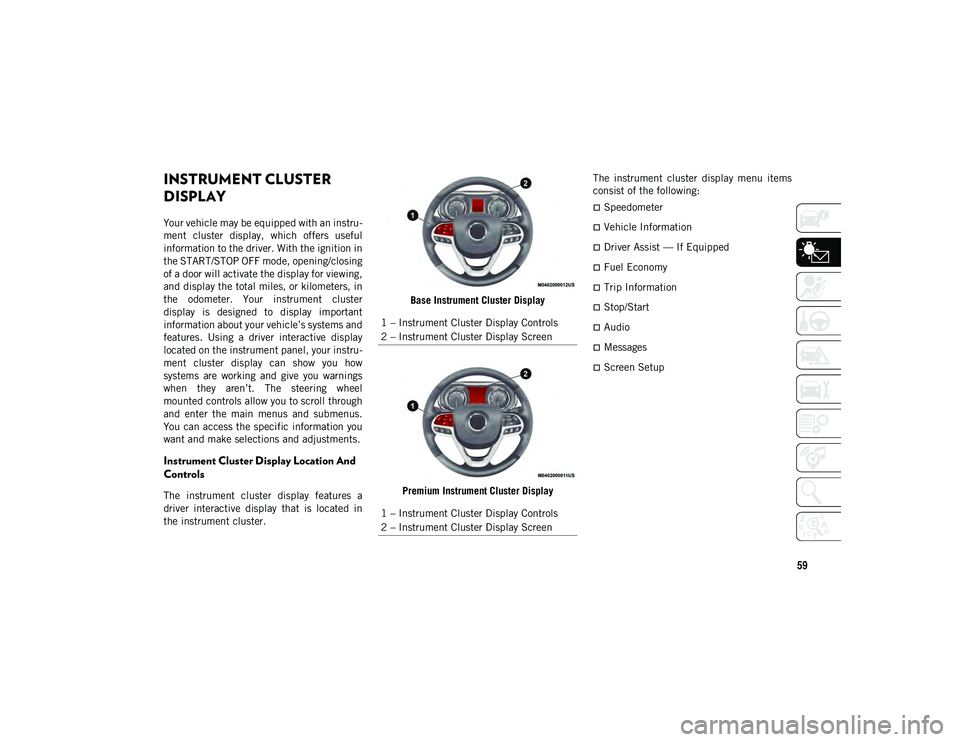
59
GETTING TO KNOW YOUR INSTRUMENT PANEL
INSTRUMENT CLUSTER
DISPLAY
Your vehicle may be equipped with an instru-
ment cluster display, which offers useful
information to the driver. With the ignition in
the START/STOP OFF mode, opening/closing
of a door will activate the display for viewing,
and display the total miles, or kilometers, in
the odometer. Your instrument cluster
display is designed to display important
information about your vehicle’s systems and
features. Using a driver interactive display
located on the instrument panel, your instru -
ment cluster display can show you how
systems are working and give you warnings
when they aren’t. The steering wheel
mounted controls allow you to scroll through
and enter the main menus and submenus.
You can access the specific information you
want and make selections and adjustments.
Instrument Cluster Display Location And
Controls
The instrument cluster display features a
driver interactive display that is located in
the instrument cluster. Base Instrument Cluster Display
Premium Instrument Cluster Display The instrument cluster display menu items
consist of the following:
Speedometer
Vehicle Information
Driver Assist — If Equipped
Fuel Economy
Trip Information
Stop/Start
Audio
Messages
Screen Setup
1 – Instrument Cluster Display Controls
2 – Instrument Cluster Display Screen
1 – Instrument Cluster Display Controls
2 – Instrument Cluster Display Screen
2020_JEEP_CHEROKEE_UG_RHD_UK.book Page 59
Page 63 of 332
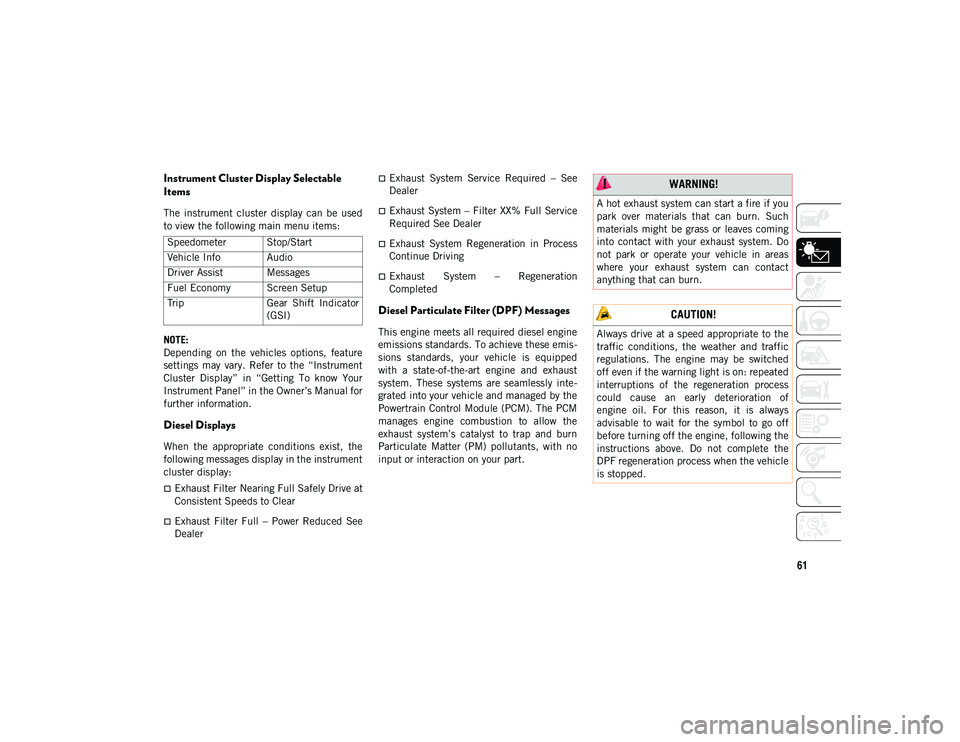
61
Instrument Cluster Display Selectable
Items
The instrument cluster display can be used
to view the following main menu items:
NOTE:
Depending on the vehicles options, feature
settings may vary. Refer to the “Instrument
Cluster Display” in “Getting To know Your
Instrument Panel” in the Owner’s Manual for
further information.
Diesel Displays
When the appropriate conditions exist, the
following messages display in the instrument
cluster display:
Exhaust Filter Nearing Full Safely Drive at
Consistent Speeds to Clear
Exhaust Filter Full – Power Reduced See
Dealer
Exhaust System Service Required – See
Dealer
Exhaust System – Filter XX% Full Service
Required See Dealer
Exhaust System Regeneration in Process
Continue Driving
Exhaust System – Regeneration
Completed
Diesel Particulate Filter (DPF) Messages
This engine meets all required diesel engine
emissions standards. To achieve these emis-
sions standards, your vehicle is equipped
with a state-of-the-art engine and exhaust
system. These systems are seamlessly inte -
grated into your vehicle and managed by the
Powertrain Control Module (PCM). The PCM
manages engine combustion to allow the
exhaust system’s catalyst to trap and burn
Particulate Matter (PM) pollutants, with no
input or interaction on your part.
Speedometer Stop/Start
Vehicle Info Audio
Driver Assist Messages
Fuel Economy Screen Setup
Trip
Gear Shift Indicator
(GSI)
WARNING!
A hot exhaust system can start a fire if you
park over materials that can burn. Such
materials might be grass or leaves coming
into contact with your exhaust system. Do
not park or operate your vehicle in areas
where your exhaust system can contact
anything that can burn.
CAUTION!
Always drive at a speed appropriate to the
traffic conditions, the weather and traffic
regulations. The engine may be switched
off even if the warning light is on: repeated
interruptions of the regeneration process
could cause an early deterioration of
engine oil. For this reason, it is always
advisable to wait for the symbol to go off
before turning off the engine, following the
instructions above. Do not complete the
DPF regeneration process when the vehicle
is stopped.
2020_JEEP_CHEROKEE_UG_RHD_UK.book Page 61
Page 64 of 332
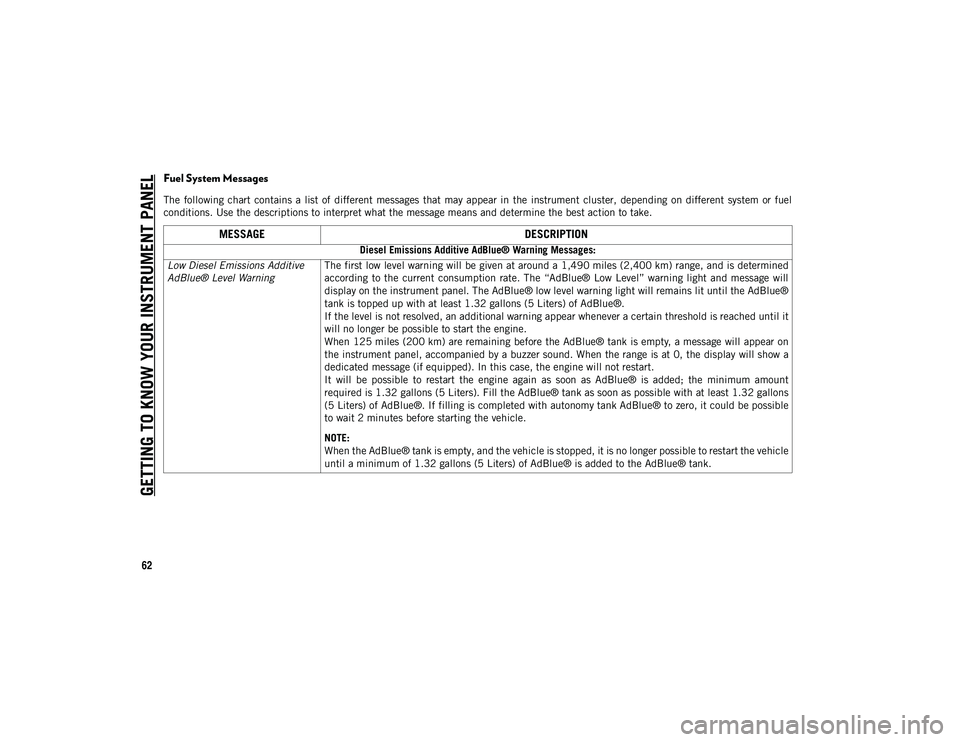
GETTING TO KNOW YOUR INSTRUMENT PANEL
62
Fuel System Messages
The following chart contains a list of different messages that may appear in the instrument cluster, depending on different system or fuel
conditions. Use the descriptions to interpret what the message means and determine the best action to take.
MESSAGEDESCRIPTION
Diesel Emissions Additive AdBlue® Warning Messages:
Low Diesel Emissions Additive
AdBlue® Level Warning The first low level warning will be given at around a 1,490 miles (2,400 km) range, and is determined
according to the current consumption rate. The “AdBlue® Low Level” warning light and message will
display on the instrument panel. The AdBlue® low level warning light will remains lit until the AdBlue®
tank is topped up with at least 1.32 gallons (5 Liters) of AdBlue®.
If the level is not resolved, an additional warning appear whenever a certain threshold is reached until it
will no longer be possible to start the engine.
When 125 miles (200 km) are remaining before the AdBlue® tank is empty, a message will appear on
the instrument panel, accompanied by a buzzer sound. When the range is at 0, the display will show a
dedicated message (if equipped). In this case, the engine will not restart.
It will be possible to restart the engine again as soon as AdBlue® is added; the minimum amount
required is 1.32 gallons (5 Liters). Fill the AdBlue® tank as soon as possible with at least 1.32 gallons
(5 Liters) of AdBlue®. If filling is completed with autonomy tank AdBlue® to zero, it could be possible
to wait 2 minutes before starting the vehicle.
NOTE:
When the AdBlue® tank is empty, and the vehicle is stopped, it is no longer possible to restart the vehicle
until a minimum of 1.32 gallons (5 Liters) of AdBlue® is added to the AdBlue® tank.
2020_JEEP_CHEROKEE_UG_RHD_UK.book Page 62
Page 65 of 332
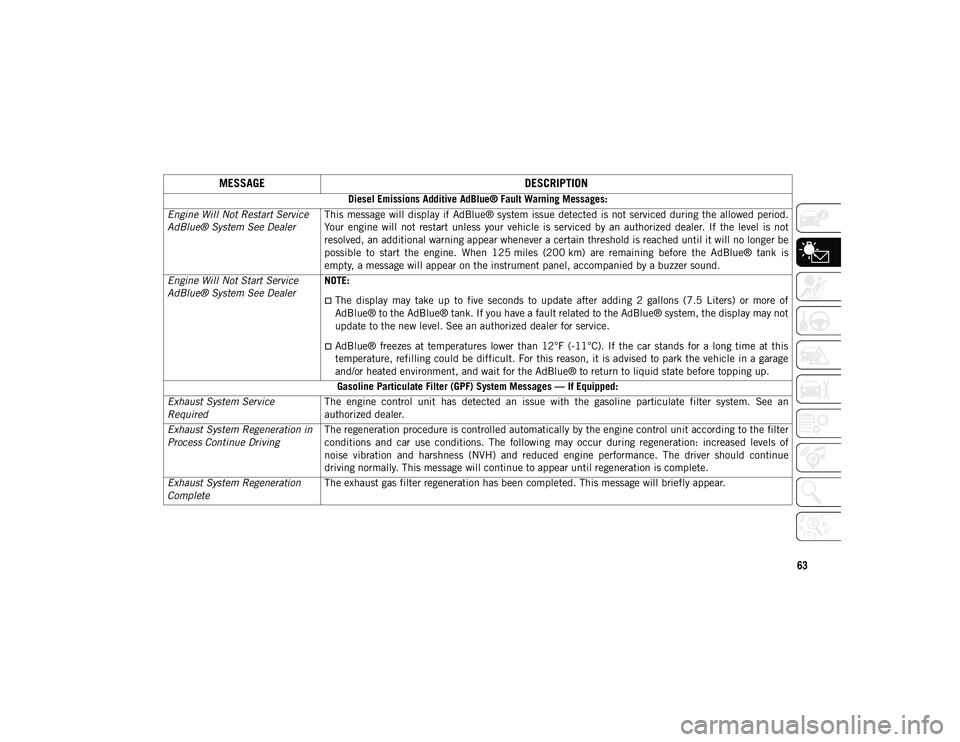
63
Diesel Emissions Additive AdBlue® Fault Warning Messages:
Engine Will Not Restart Service
AdBlue® System See Dealer This message will display if AdBlue® system issue detected is not serviced during the allowed period.
Your engine will not restart unless your vehicle is serviced by an authorized dealer. If the level is not
resolved, an additional warning appear whenever a certain threshold is reached until it will no longer be
possible to start the engine. When 125 miles (200 km) are remaining before the AdBlue® tank is
empty, a message will appear on the instrument panel, accompanied by a buzzer sound.
Engine Will Not Start Service
AdBlue® System See Dealer NOTE:
The display may take up to five seconds to update after adding 2 gallons (7.5 Liters) or more of
AdBlue® to the AdBlue® tank. If you have a fault related to the AdBlue® system, the display may not
update to the new level. See an authorized dealer for service.
AdBlue® freezes at temperatures lower than 12°F (-11°C). If the car stands for a long time at this
temperature, refilling could be difficult. For this reason, it is advised to park the vehicle in a garage
and/or heated environment, and wait for the AdBlue® to return to liquid state before topping up.
Gasoline Particulate Filter (GPF) System Messages — If Equipped:
Exhaust System Service
Required The engine control unit has detected an issue with the gasoline particulate filter system. See an
authorized dealer.
Exhaust System Regeneration in
Process Continue Driving The regeneration procedure is controlled automatically by the engine control unit according to the filter
conditions and car use conditions. The following may occur during regeneration: increased levels of
noise vibration and harshness (NVH) and reduced engine performance. The driver should continue
driving normally. This message will continue to appear until regeneration is complete.
Exhaust System Regeneration
Complete The exhaust gas filter regeneration has been completed. This message will briefly appear.
MESSAGE
DESCRIPTION
2020_JEEP_CHEROKEE_UG_RHD_UK.book Page 63